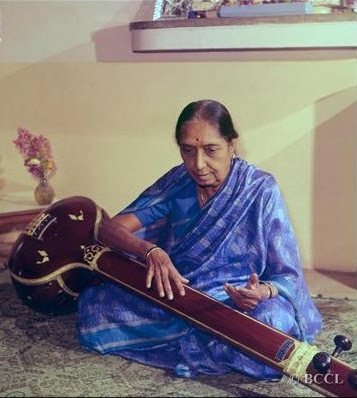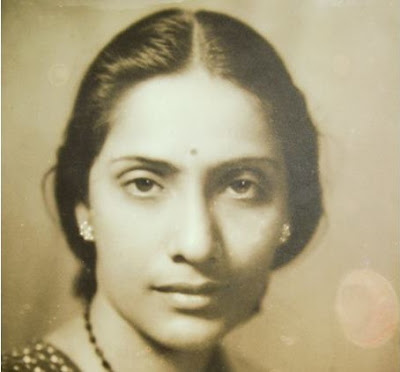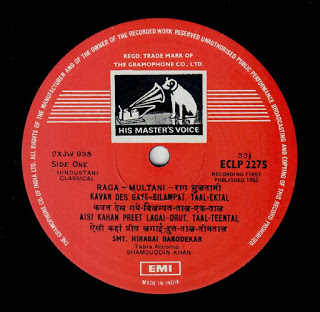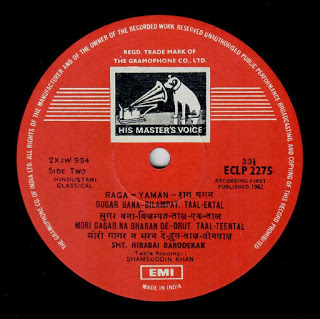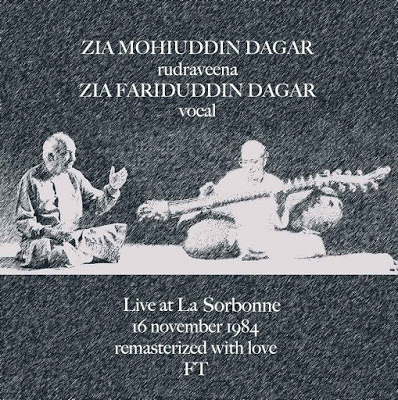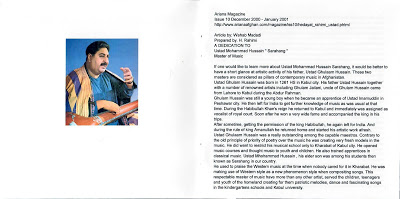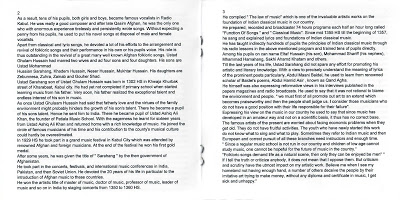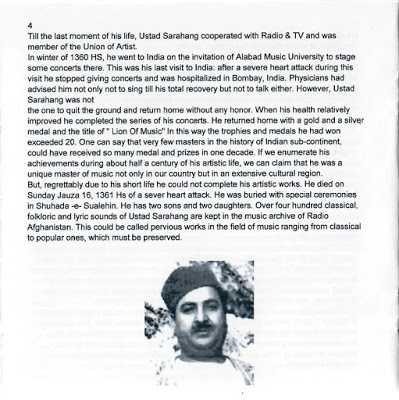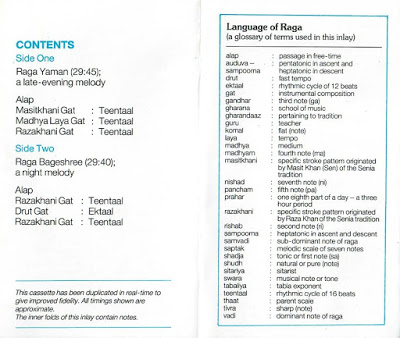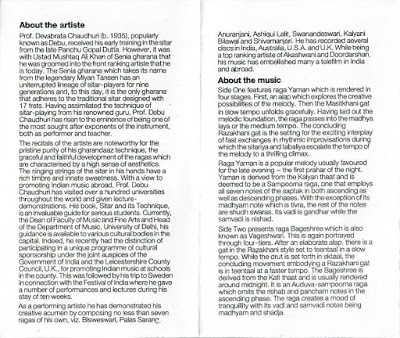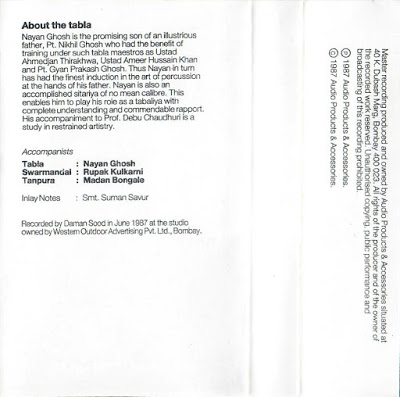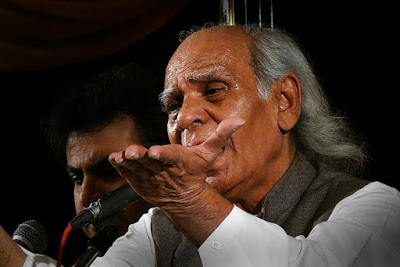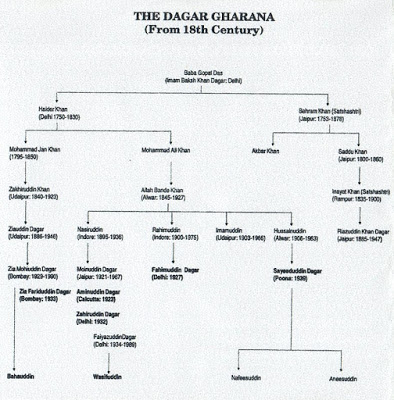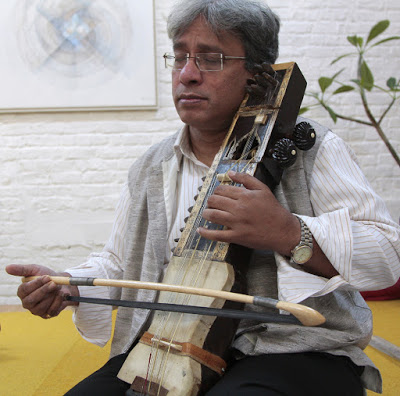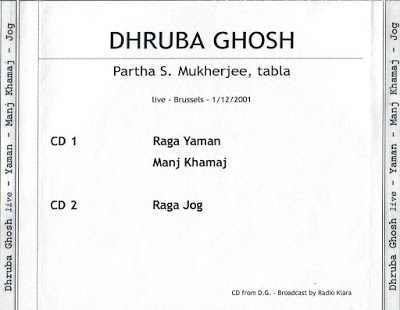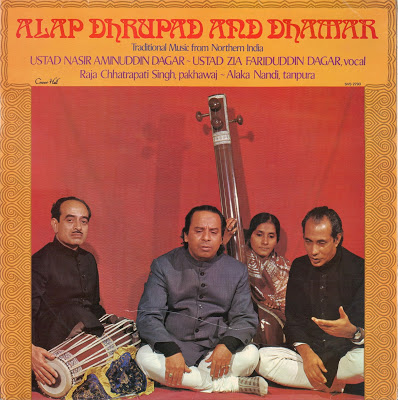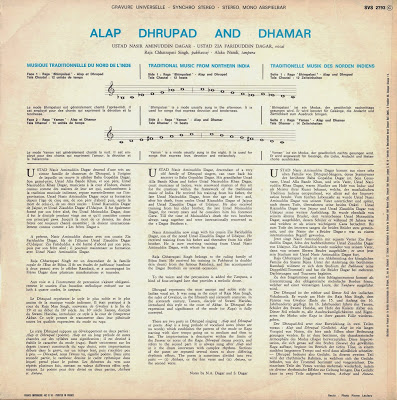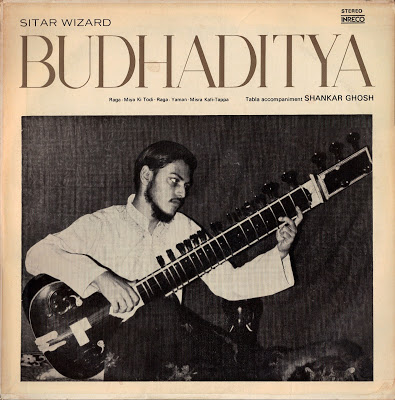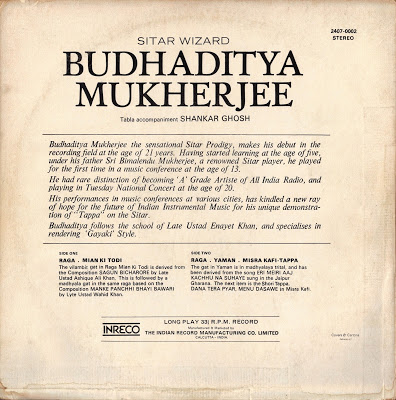Hirabai Barodekar (1905-1989) was amongst the most distinguished and popular Hindustani vocalists of the 20th century, and almost certainly the most melodious female voice heard in recent times. She was the eldest daughter of the Kairana gharana founder, Ustad Abdul Kareem Khan, but trained primarily by her father’s associate and Kairana co-founder, Ustad Abdul Waheed Khan. She exploded upon the scene while the giants of the pre-independence era still ruled the concert platform, and remained amongst the most respected vocalists thereafter, sharing the stage with the likes of Ameer Khan, Bade Gulam Ali Khan, and Kesarbai Kerkar.
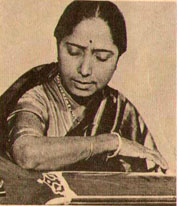
In a busy career spanning over 45 years, Hirabai captured the hearts of millions with her renditions of Khayal, Thumree, Natya Sangeet, Bhava Geet, and Bhajans on the concert platform, in the regional theatre, through radio broadcasts, and through commercial recordings. Even after her voluntary retirement in 1973, she accepted the position of a Resident Guru at the ITC Sangeet Research Academy, which she served until 1976.
Accessibility was the cornerstone of her music. She arrived on the scene at a time when classical music was just emerging from the era of aristocratic patronage, during which it had lost its touch with the mainstream culture. By the time of her arrival, the missionary work of Vishnu Digambar had begun to make knowledge of music widely accessible to all segments of society, and the radio and the gramophone had begun to deliver classical music into people’s homes. Her music was a product of the cultural revolution that was taking place in her times. She delivered the highest quality of classical music in accessible packages, and helped it gain a place in the mainstream culture. Hirabai’s career, however, represents a cultural revolution in several other respects.
Hirabai entered the regional theatre as a singer-actor at a time when there had been no plays with a mixed caste of men and women for 90 years (1843-1929). Audiences were entirely male, and men performed female roles and also sang in female voices. With her entry, women started performing on stage, and female audiences started growing. The quiet revolution she wrought was similar in the classical music segment.
Until she arrived on the scene, professional female singers (or dancers), who performed in public, carried a stigma of a low-brow culture. Their art was ostensibly designed only for male titillation, and they got paid in proportion to their feminine charms perhaps more than their artistic accomplishments. In 1925, Hirabai became the first female vocalist ever to present a ticketed concert in an auditorium, with audiences paying for her art, and men and women from genteel society feeling free to participate in the cultural process.
In both the contexts of direct interface with audiences, Hirabai made female musicianship respectable with her art, and impeccable conduct. On the concert platform, she was always conservatively dressed, and moderately adorned with jewelry. She conducted herself with dignity and without the feigned modesty commonly encountered in the musical culture of the era. Her public persona, her music, and her personality were in perfect congruence with each other. Her music exuded peace and warmth, as much as her relationships did. If her music was an elixir of tranquility, it was so because, as a person, she was totally above greed and competitive anxiety. She performed her music, and conducted her life in the same manner -- with quiet confidence devoid of arrogance or intimidatory intent.
Despite the accessibility of her music, Hirabai represented formidable musicianship. Pandit Bhimsen Joshi, Hirabai’s junior amongst Kairana vocalists, said: “She is an outstanding exponent of Kairana vocalism. Especially, her command over swara, laya, and tala. Her music is a fitting reply to those who allege that Kairana vocalism has only swara and no laya or tala. Gifted with a voice without any blemishes, once she begins singing, she enchants with every vocal expression at her command.” Ramkrishna Buwa Vaze, her teacher for a while, said: “Hirabai’s music can make a sick man feel healthy”.
In recognition of her contribution to music and the stature she had earned, Hirabai was honored by the Sangeet Natak Akademi in 1965, and awarded the Padma Bhushan by the President of India in 1970.
Childhood and grooming
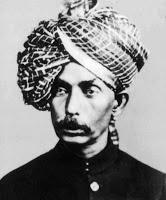 |
| ABDUL KAREEM KHAN |
Hirabai Barodekar was the second of the five surviving children of Ustad Abdul Kareem Khan, and his disciple, Tarabai Mane, who took on the Muslim name of Tahira Bibi upon her marriage to him. Hirabai (named Champakali at birth), along with her elder brother, Suresh Babu (named Abdul Rehman at birth), were initiated into music in early childhood. By the time Suresh Babu was 7 and Hirabai was barely 4, the proud father, Abdul Karim Khan began showing off their prodigious talent by making them perform short duet items at his own concerts in different parts of the country.
Hirabai’s early life in music was full of turmoil. According to some accounts, her father wanted to reorient his pubescent daughters towards a "respectable" life as householders rather than continue training in music. Hirabai circumvented this restriction by overhearing the training being given to his male disciples, especially her brother, Suresh Babu. Thereafter, while Hirabai was in her early teens, she had to face the consequences of parental discord. Her mother, Tarabai quit the Ustad's home, with their five children in tow, to start a new life in Bombay. To make a complete break from the past, she scrapped the family’s Muslim names, and adopted her maiden surname (Mane) for her sons, and Barodekar, the generalised description of the Maharashtrian community in Baroda, as the surname for the daughters.
It was an era of growing demand for music education, and music schools were coming up all over Maharashtra. In order to support the family, Tarabai opened a music school, where she and her eldest son, the 17-year old Suresh Babu were the main teachers. They also taught Hirabai. In addition, Hirabai was tutored, for short periods, by Mohammad Khan of the Agra gharana, and Ramkrishna Buwa Vaze, the Gwalior-trained original. But, Tarabai had to worry about giving her children the quality of training worthy of Abdul Kareem Khan’s lineage. The solution emerged through her friendly neighbors, Zohrabai and her daughter Munnibai, who were disciples of Ustad Abdul Waheed Khan, a kinsman and close associate of Abdul Kareem Khan. Zohrabai persuaded Abdul Waheed Khan to teach Suresh Babu and Hirabai.
Abdul Waheed Khan, though an affectionate father-figure to the promising teen-agers, was a tough taskmaster. His training was grueling, with each raga being taught for six months, with no concessions for boredom. Hirabai was a quick learner, and a hard-working disciple. The mentor himself acknowledged that Hirabai could master in a year what others would take four years to grasp.
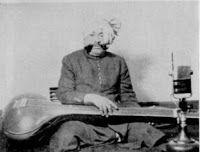 |
| ABDUL WAHEED KHAN |
In 1922, Vishnu Digambar Paluskar, the renaissance man of Hindustani music, invited Hirabai and Suresh Babu to perform at the annual day of the Gandharva Mahavidyalaya. The 17-year old Hirabai excelled and her performance and sent ripples of excitement through the music community at the arrival of a great new voice. Her mentor, Abdul Waheed Khan, took it badly as she had performed without his permission. Soon thereafter, Hirabai and Suresh Babu were invited to play roles as singer-actors in musical theatrical productions. Abdul Waheed Khan saw this direction as unbecoming of a high-brow lineage of musicians, and terminated the training of Hirabai and Suresh Babu. This was the year 1922, just about four years after they had commenced training with the Ustad.
In the profession
Starting from 1923, Hirabai began a hectic concert schedule, traveling widely with Suresh Babu as companion and Harmonium accompanist. In the same year, she launched her career as a recording artist which was to deliver almost 200 recordings to a hungry public over the next 45 years with the three major recording labels – HMV, Odeon, and Columbia. She continued to work sporadically in the regional theatre, while she traveled the lengths and breadth of the country charming audiences.
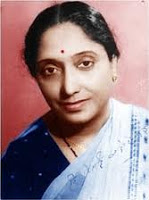
In 1924, Ustad Alladiya Khan of the Jaipur-Atrauli gharana organized a major musical event in Bombay, and invited Hirabai and Suresh Babu to perform. Once again, the two gave brilliant performances, obliging Alladiya Khan to pay handsome compliments to their talent and grooming. In 1937, Kesarbai Kerkar, the Empress of the concert platform, recommended Hirabai for invitation to the prestigious All India Music Conference in Calcutta, and took pride in introducing a new star. These endorsements added immensely to her reputation, and her concert career maintained its upward graph.
Lured by the buoyancy of the Marathi regional theatre, and her children’s talent for musical productions, Tarabai launched a drama company in 1929 as an adjunct to the music school she ran, so that all her children could be gainfully employed. Hirabai and Sureshbabu were assigned stellar roles. In this venture, Tarabai had the solid support of some of the finest musicians amongst theatre personalities of the times – Govindrao Tembe, Bal Gandharva, Master Krishnarao, Sawai Gandharva, and Vinayakrao Pathwardhan. The company produced three plays – Sanshay Kallol, Sangeet Saubhadra, and Sadhvi Mirabai. The plays featured superlative music, and were tremendously successful. But, the venture itself wall ill-fated.
Audiences started thinning as the era of talkies dawned. In 1933, the company downed shutters, with the family deeply in debt. Lawyers advised the declaration of insolvency and reneging on the debts. Hirabai refused, and took on the entire burden of debts pledging her professional earnings towards redemption. She swore thereafter never to work in the theatre.
That resolution was not easy to maintain. In 1944, ten years after she decided to quit theatre, her close friends and associates, Bal Gandharva and Master Krishnarao, persuaded her to revive her old play, Sangeet Saubhadra. The play was a thundering success, often starting at 10 pm and ending at dawn, with each song having to be sung several times on public demand. Thereafter, she accepted roles in Marathi films, and acted in three of them – Swarna Mandir, Pratibha, and Sant Janabai. Only the last one did well. After the failure of her films, she said goodbye, once and for all, to theatre and films.
In the mean while, in 1929, barely two years after the launch of the Indian Broadcasting Corporation (later, All India Radio), she began broadcasting her music. Through the “chain-booking” system of the broadcasting company, she performed on all stations in the country, from Kashmir to Calicut. Radio executives have lost count of her broadcasts over her 45-year broadcasting career; but do recall that her acceptance rate for radio bookings was close to 100%. In 1977, at the Golden Jubilee celebrations of All India Radio, Hirabai was honored by the Prime Minister of India as a stalwart broadcaster.
The stature, respect and affection Hirabai enjoyed amongst audiences and musicians alike was enviable. In 1946, the ultra-conservative Harballabh Sangeet Sammelan of Jallandhar, broke its 50-year convention of inviting only male musicians, and invited Hirabai to perform. At another prestigious music festival in Calcutta, KL Sehgal, the legendary singer-actor, interrupted her performance and walked up to the stage to present to her as many as 12 gold sovereigns gifted by members of the present audience in gratitude for her music. In 1947, when India gained independence, Hirabai was invited to broadcast the national song “Vande Mataram” at midnight of August 14-15.
For the better part of 45 years, until she put aside her Tanpura in 1973, Hirabai Barodekar was everywhere – on the concert platform, on gramophone records, on the radio, and in the regional theatre. Hers was one of the busiest careers amongst the musicians of her era. She lived with her travel kit ready at all times to respond to an invitation to perform anywhere in the country. She traveled willingly at short notice, by whatever means of travel was available, irrespective of discomfort, and remained indifferent to the level of hospitality she received from her hosts. Economics was, no doubt, the driving force. She was the bread-winner for a family of 25 dependents, including those of her siblings – especially after her brother, Suresh Babu died in 1952. She earned well, lived simply, redeemed the debts of her mother’s theatre company, remained a gracious hostess throughout her life, and had enough to retire in modest comfort.
Musicianship
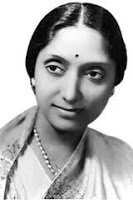
Hirabai Barodekar’s repertoire covered five genres of music – Khayal, Thumree, Natya Sangeet, Bhava Geet and Bhajans. On rare occasions she also sang Ghazals. She was an unquestioned master of the Khayal and Natya Sangeet, though some of her Bhava Geet and Bhajans also became very popular. Almost two-thirds of her commercial recordings belong to the Khayal and Natya Sangeet genres. Her Thumree repertoire, too, had its admirers. Connoisseurs of her times, however, felt that, she did not have the temperament to do full justice to the seductive character of the genre. Her discerning contemporaries also believed that her involvement with the theatre did a lot of good to her competence as a classical vocalist. The acoustics of play houses in her times (devoid of amplification) trained her to throw her voice with a controlled consistency of timbre and volume – a great asset in the context of concert hall electronics. The demands of theatre music perhaps also helped her avoid the “more educative than entertaining” tag of her Guru, Abdul Wahid Khan.
Hirabai was aware that her formal training had been too short to justify her pedigree, and remained passionate about learning as much as she could from any obliging source. She routinely invited great musicians to perform at her residence, and learnt from them anything that caught her fancy. She had a close association with the scholar-musician, Vasantrao Deshpande, from whom she received guidance in classical music as well as Natya Sangeet. Through one of the wealthy patrons of that era, she became friends with the celebrated Thumree singer, Gohar Jan, and learnt several Purab style Thumrees and Ghazals from her. The legendary Natya Sangeet singer, Bal Gandharva, was her friend and colleague in the theatre. From him, she learnt many of the songs from his plays, and performed them widely in her own style.
Her classical repertoire was limited to the common and mature ragas preferred by Kairana gharana vocalists – ragas like Yaman, Bhoop, Shuddha Kalyan, Marwa, Malkauns, Multani, Basant, Miya Malhar, Todi and Bhairavi. When audiences requested her to sing a raga she did not know, she honestly admitted that she did not know it. It never bothered her that she did not have the esoteric repertoire that many vocalists of her era flaunted as hallmarks of musicianship. Under the most challenging conditions, she could melt the hearts of her audiences with what she knew.
Hirabai was a brilliant concert planner. She had an intuitive grasp of what repertoire would work with specific audiences. Unless placed under time constraints, she could hold audiences enthralled from 10 pm to 4 am, a common requirement of musicianship in her times. She could handle the occasional unpleasant surprises of the concert situation with great composure. At one festival in Calcutta, Hirabai’s cousin Roshanara Begum, scheduled to perform ahead of her, was in a nasty mood. Roshanara decided to wind up her own concert with Bhairavi, conventionally the last raga of an evening. Concert hosts were embarrassed by this affront to Hirabai’s stature by Roshanara. Hirabai was unperturbed. She went up to the stage, tuned her Tanpuras, and started raga Maru Bihag exactly as she had planned, and had the audience eating out of her hands in a few minutes.
Like Kesarbai amongst her seniors, Hirabai maintained a stable relationship with her accompanists. Her ensemble always consisted of Baburao Kumthekar on the Sarangi, Shamsuddin Khan on the Tabla and Rajabhau Koske on the Harmonium. The stability of these relationships contributed immensely to the rapport between the musicians, and to the harmonious and effortless delivery of music.
The most significant facet of Hirabai’s musicianship was her voice. In recent times, no other voice has inspired as much poetry and poetic prose as did Hirabai’s. Leading litterateurs of her times compared it to the soothing glow of the sky on a full-moon night. Hers was a voice soaked in honey, and yet crisp enough to enable the crystal clear execution of her musical ideas through two octaves. In the pitch-precision and intonation department, she was arguably the only female vocalist of the century who could hold a candle to the legendary perfection of her father, Abdul Kareem Khan. In addition to nature’s gift, her voice was a product of assiduous cultivation. No matter how late in the night she had retired, she never missed her pre-sunrise exercises for keeping the voice in fine fettle. She routinely practiced for four to five hours a day, irrespective of where she was.
Despite the diversity of her repertoire in terms of genres, her music in each genre was faithful to its esthetics. Her Khayals retained their formal aloofness, and were never in danger of becoming Thumrees. Nor did they ever drift towards the more entertaining stylistics of Natya Sangeet. Despite the variety of influences on her style, Hirabai’s Khayals were her own, and yet bore the unmistakable stamp of melody-dominant Kairana vocalism. Hers was disciplined music, but without the academism of Abdul Waheed Khan. Hers was intelligent music, without ever becoming a display of either cleverness or scholarship. Her intellect was deployed, instead, towards refining the aesthetic sensibility that guided her music. Her music thus acquired a universal appeal, appreciated by the laity as well as connoisseurs.
Even her admirers admitted that her music lacked daring experimentalism and the element of surprise evident in the vocalism of, say, Kesarbai Kerkar. Hirabai’s music was a reflection of her personality, which was essentially conservative, mellow, warm and affectionate. Her father’s music was steeped in Karuna Rasa (the sentiment of pathos). Her Guru, Abdul Waheed Khan’s music was very cerebral. Hirabai’s musical personality belonged to the territory of Shanta Rasa (the sentiment of peace and tranquility) and Vatsalya Rasa (the maternal sentiment).
The architecture of her Khayal presentations was flawless, corresponding to the two-tier Kairana structure with an alap followed by tan-s. Her alap was amongst most celebrated alaps of her era. She constructed it like an exquisite string of pearls, carefully evaluating every phrase for its beauty, and stringing it meticulously to create a well-knit melodic experience. The most widely admired facet of her alap was her ascent to the upper-Sa in the antara. The ascent was so astutely constructed that, the reposeful arrival at the upper-Sa became an ecstatic experience. Amongst her seniors of the era, Kesarbai’s antara-s were equally valued. But, there was a difference. Kesarbai made the audiences’ jaws drop in marvel. Hirabai’s anatara-s, instead, penetrated their consciousness, and sent them into a trance. Hirabai’s virtuosity in the tan-s department was no inferior to that of her major contemporaries. But, unlike them, she constructed and rendered them with simplicity and warmth that were innate to her personality, rather than to intimidate.
Despite her classicism, and the passage of time, Hirabai's music shows no signs of aesthetic obsolescence and retains its appeal to this day. One of the tragedies for later generations of music lovers is that very little of her music has been published on concert-length media, and very few of her concert recordings are in circulation amongst archivists. The most inexplicable aspect of this reality is that All India Radio, the holder of the largest Hirabai archive spread over her entire performing career, has ignored her in its programme for the commercial release of their musical assets.
(c) Deepak S. Raja 2011
